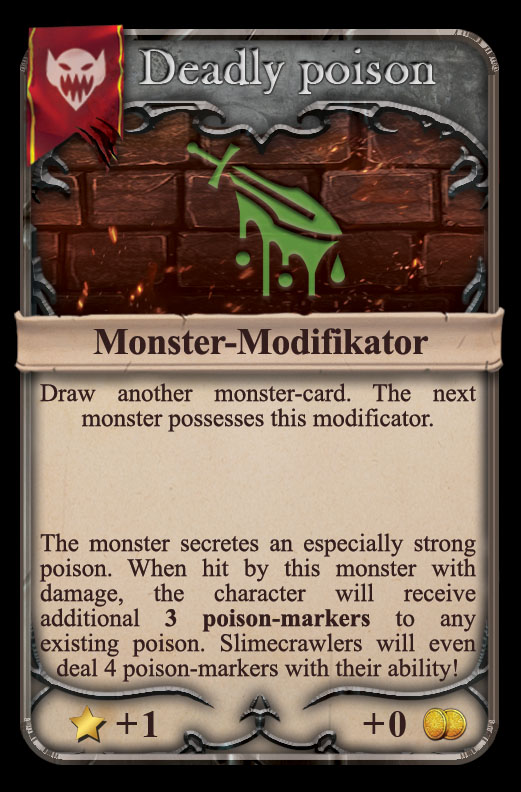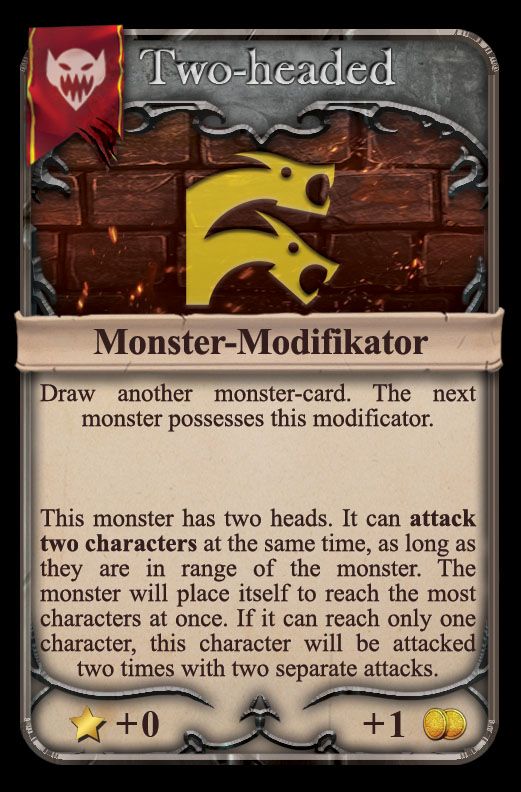Welcome back to the features of Dungeons of Doria. In the last 2 parts we learned how room tiles lead to a (mostly) random dungeon with each play and how the initiative system works.
This time, we want to concentrate on another random game mechanic: As Dungeons of Doria is played cooperatively and there is no dungeon master, the game also needs to deal monsters automatically. At a first glance, the game has a pretty standard deck of fantasy type monsters: Orcs, Goblins, Ogers, Trolls, undead hordes like Zombies, Mummies and Vampires, some ranged fighters like Archers and Troll-Spearthrowers and the occasional dark wizards and shamans. The only exception might be the centipede-like Slimecrawler, that is native in Doria (the fantasy world of ERPS).
Normally, each monster moves automatically to the closest hero to attack on the fastest possible way. However, the rules make an exception whenever the Monster can hit more than one hero at the same time, so some of the monsters might already walk a different path than expected. Additionally, each monster has its own unique skill. These skills might be something simple and passive (like Skeletons, which cannot be attacked with ranged weapons) or might be a bit more complex (for example with archers, who will not attack the nearest character, but the one with the lowest Agility-value).


But on top of all that, there is the mod-system: The basic monster deck consists of around 100 monster cards. Depending on the rarity of each monster, there is a higher or lower number of cards for the monster in the deck – for example, the mighty Troll is available 2 times and the Slimecrawler 10 times. In addition to these simple random monster selections, the deck contains 50 monster-modifications. These mods give the monster more abilities, something from additional elemental damage or doubled attack range to 4 hands that allow for multiple attacks.
The mod system is what makes the random monsters fun. You never know, what will happen with the next monster. Sometimes the game knows exactly how to hit you at the right spot, sometimes there is this absurd combination of two heads and 4 hands or the really ancient Goblin with additional armor that is REALLY hard to kill… Sure, there might also be mods that have nearly no effect at all – but in most cases they trigger the heroes to at least kill this specific monster faster – and might do something dangerous and go out of their way of normal play and do something more rushed.
Based on the rough 100 to 50 card ratio, every second monster might get a mod – if fate decides to do so. In many cases, there will be 4 or 5 monsters without any mods. And then there is this ultimate monster, that has 4 hands, an additional shield, is running faster and is resistant to magic attacks…
Many play testers have stated, that having random monsters with these additional random modifications is one of the key features of Dungeons of Doria. It is just fun to see, how monsters can evolve to be more than a standard fantasy type monster – even if they still are.
Other articles on the Dungeons of Doria feature-series (planned or published):
Part 1: The modular dungeon
Part 2: Time is precious: The initiative-system
Part 3: Random Monsters
Part 4: Characters – Unique and still the same

